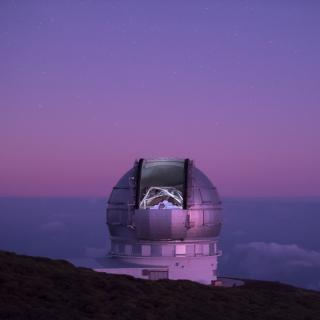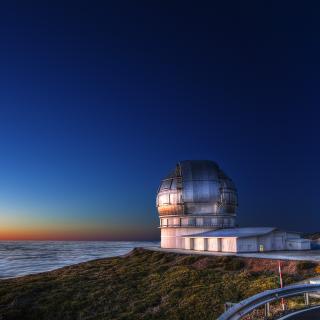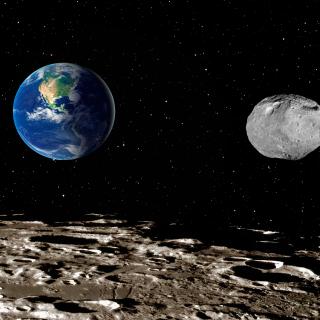Next Friday, October 10th, at 10:45 AM, the opening act for the two new telescopes: MAGIC and MERCATOR, will take place at the Observatorio del Roque de los Muchachos, in La Palma. The inauguration has been organized by the Catholic University at Leuven (Belgium), proprietor of the MERCATOR telescope, and responsible for the international consortium that manages MAGIC, in association with the Instituto de Astrofísica de Canarias (IAC). Important figures belonging to the Ministry of Science and Technology, the Government of the Canaries, and from the countries that participate in both projects ( Germany, Switzerland, Italy, Belgium), besides local authorities and important scientists, will assist to the opening.
In spite of the fact that they are being inaugurated on the same day, each telescope presents very different technical characteristics and purposes. MAGIC has a “giant” collector 17 meters in diameter, destined to detect high energy cosmic rays. On the other hand, MERCATOR is an optical telescope of 1,2 m. MAGIC is an acronym for Major Atmospheric Gamma Imaging Cherenkov, and MERCATOR owes its name to the great 18th century Belgian astronomer and cartographer.
MAGIC: high-energy science
The MAGIC telescope is the result of the collaboration of different universities and research institutes around the world, with a strong Spanish presence. The main detector has been built by the Instituto de Física de Altas Energía (IFAE), in Barcelona, that works in association with the Universidad Complutense de Madrid (UCM) and the Universidad Autónoma de Barcelona (UAB).
MAGIC is a Cherenkov telescope, the biggest in gamma ray detection in the world. This type of high-energy radiation cannot be detected directly from Earth because it is absorbed by the atmosphere. In this process, a cascade of particles that emit light in the blue UV range is generated in a very short period of time. This glow is known as “Cherenkov radiation,” which is what MAGIC will be detecting.
This telescope will allow for the exploration of a range of energies until now inaccessible. In order for this to be possible, it has significant technical improvements with respect to the previous generation of Cherenkov telescopes: higher accuracy, more efficiency, and easy handling due to its light structure. Some of the scientific projects that will be completed are related to gamma ray bursts (GRBs), active galactic nuclei, and dark matter; the latter related to the Supersymmetric Theory of Particle Physics.
MERCATOR: a versatile telescope
This telescope includes the technology developed for latest generation telescopes; it is equipped with detectors that will allow for research at a level that, years ago, was only feasible with large telescopes.
One of the purposes of this instrument will be to carry out those projects that require prolonged observation time, like in Astroseismology (the study of stellar oscillations). Another function related to high-energy emission is the study of explosive episodes of sources associated with compact objects (for example, neutron stars or black holes), phenomena that require fast tracking from Earth. MERCATOR will also study gravitational lensing, in which an astronomical object, due to its mass, causes the bending of the light coming from another object that is farther away; moreover, these types of studies allow for the detection of planets around the object that deflects the light.
CCI meeting
Coinciding with the inaugurations, on Saturday, October 11th, at 9 AM, the half-yearly meeting of the Comité Científico Internacional (CCI) of the observatories of the IAC, will take place. In this meeting, the situation of the telescopes currently installed in the canary observatories will be discussed, and new projects will be presented (GTC, GREGOR, STELLA, and OTA). Other subjects will be talked about, such as the Centro Astronómico Común de la Palma (home to the IAC on the island), the ENO-net web, and the Programa de Tiempo Internacional. The reports corresponding to the operation of the Observatories will also be presented.
We ask that the media representatives interested in coming please confirm, as soon as possible, their attendance so that we can have their certifications ready.
Contact information:
Telephones: 922 605 206 or 922 605 371
E-mail: cpv [at] ll.iac.es (cpv[at]ll[dot]iac[dot]es)


